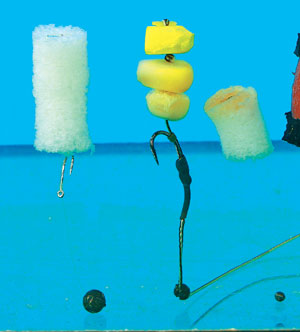What Exactly Is A Pop-Up?
It’s a buoyant bait that’s held down by a weight, be it a shot or rig putty. Most of the time, anglers pop up a bait only a matter of inches off the bottom, but any bait fished sub-surface is effectively a pop-up, so a zig rig is effectively a bait popped up well off the bottom. The main bait you will see termed pop-up is the floating boilie. Sinking boilies can be made to float by punching out the middle and adding rig foam. Indeed, rig foam in various colours is key to getting naturally sinking baits to pop up, as you will see throughout this feature. Many of the artificial baits featured earlier in this issue are available in floating forms and thus make ideal pop-up baits.
Why Would You Pop Up?
There are number of reasons but the main one is to create a hook bait that stands out from those on the bottom. You might think that fish would be wary of a bait not sitting with the others, but once fish start competing for food then a pop-up will often be taken more readily than the other baits, simply because it stands out. Pop-ups are also invaluable on silty or weedy bottoms when a normal bottom bait might end up hidden from view. Another occasion for choosing a popped-up bait is when fishing close to features where a lot of fish patrol the edge, looking for food that drops into the water. If you fish a bait on the deck and a lot of fish start to graze and forage, there’s a good chance that you will foul hook one. By popping the bait up an inch or so it’s pushed away by the movement of water as fish pass by, and is less likely to catch on a fin or outside of the mouth. The movement also catches the fish’s attention, especially if the water is coloured, so it can boost your chance of catching.
How Do You Fish A Pop-Up?
Other than worms and maggots, pop-up baits are invariably fished on a hair rig. They sit in the water with the bait at the highest point, the hook hanging clear of the bait below and the weight on the hooklength governing how far the bait sits off the bottom. There are two schools of thought as to how much weight to use. If you use a large shot like an AAA, the weight of this may well help set the hook as the fish picks it up. On the other hand, a careful fish could easily feel the weight and spit the hook out before you have a chance to react. The other way of looking at things is to use the minimum amount of weight possible to hold the bait down. This can be surprisingly little, and the bonus of this tactic is that the fish is unlikely to feel anything is wrong and thus will take the bait properly. A piece of bread, for instance, might only need a No8 shot to hold it down. The only way of working out how much you need is to test things in the margins, or in a tub of water.
Popped-Up Worms
Lobworms are big and tough enough to be injected (carefully) with air, using a syringe. Most shops selling predator tackle will have a suitable one for sale. This allows the angler to present a juicy, wriggling bait that dances off the bottom like a mini cobra and which can’t burrow into the weed or into the bottom out of view of passing fish. Air is best injected into the head just below the lobworm’s saddle. For safety reasons be sure to inject away from your fingers – accidentally injecting air into your own bloodstream would be highly dangerous. Popped-up lobworms will catch all manner of species, but are especially effective for specimen perch. They are a really good bait in winter when the big perch are less included to chase fry and so are harder to catch on spinners and livebaits. The trick is to position the shot on the hooklength that holds the bait down so that the bottom of the tail is touching the lake or riverbed when it’s in the water.
Popped-Up Sweetcorn
One of the big plusses of sweetcorn as a bait is that it’s bright and very visual when on the bottom. Popping it up just off the bottom enhances this further, but you need to add something buoyant to make it float. Fish are not stupid and it’s important to try and use something that blends in with the corn, and ideally looks like another grain. The easiest solution is to use one of the floating, fake sweetcorn baits made by the likes of Korum, CFS, Enterprise Tackle and Alien Baits. Enterprise does a mini piece of floating corn with a ridge through the middle to act as a hair stop, which we particularly like at tcf. The other option is to cut out a piece of rig foam into the shape of a grain of corn using a pair or scissors, and use this piece nearest the hair stop, with a couple of real grains between it and hook. It is best popped up just a couple of inches off bottom.
Popped-Up Maggots
As you’ll see later in this guide, maggots can be made to float quite easily. Add the right size of weight and hook and you can create an almost neutral-density bait, which is very easily sucked in by a fish that might be gill feeding on groundbait. To pop up maggots you’ll need some of the floating artificial grubs. With a small bunch of maggots one should be enough to make the whole hook bait float. Another option is to use one of the Korda maggot clips with two or three floating maggots, plus some real ones. This creates a bait that pops up and also wriggles like a Medusa’s head for added attraction. Maggots are best popped up just a couple of inches off bottom.
Popped-Up Bread
Like corn, one of the great attractions of bread is that it’s such a visual bait and especially so in clear water, making it a deadly winter offering. The difference with bread is that because it contains a lot of air it pops up without any assistance, as long as you don’t squeeze all the air out of it. The trick is to squeeze a piece of flake around the shank, but leave the bread around the hook fluffy. A 50p-sized piece of flake needs very little weight to hold it down – a No8 shot might be enough. A lot of anglers don’t have the confidence to leave a bait like this out for long because they think it comes off the hook – but take our word for it that it will stay on much longer than you think. It’s worth experimenting with how far off the bottom you pop up bread. Sometimes in the depths of winter the fish will be in a warmer thermocline, which could be at any layer in the water. Breadcrust is also good as a popped-up hook bait, fished on a hair with the hair stop in the crusted side.
Popped-Up Casters
These are an absolutely fantastic bait for specimen fish like tench and bream, but quite difficult to prepare. The best bet is to feed a bed of real casters, perhaps with some hemp and groundbait and dead maggots, and pop up a bunch of floating artificial casters off a hair just a couple of inches above the bed of feed by supergluing them to it. A fashionable bait on the specialist tench scene at the moment is the combination of real and imitation casters (see pages 48 to 49). You could, of course, also just use casters that have been left out in the air until they float. The downside of these is that they can easily be damaged by small fish, whereas imitation casters withstand such unwanted attention.
Rules And Regulations
Note that many commercial fisheries don’t allow the use of any artificial baits, so the use of rig foam or fake baits to help the pop-up process is not permitted. Artificial baits are also banned on most matches, certainly in any events fished to National Federation of Anglers’ rules. Surface fishing is also prohibited on many waters, but many of those waters allow subsurface baits, meaning pop-ups are allowed.
‘How To’ Links






